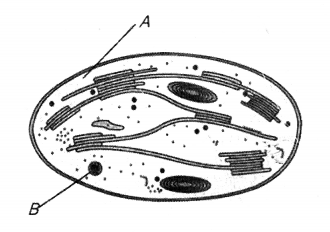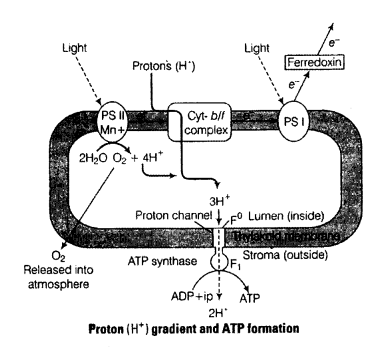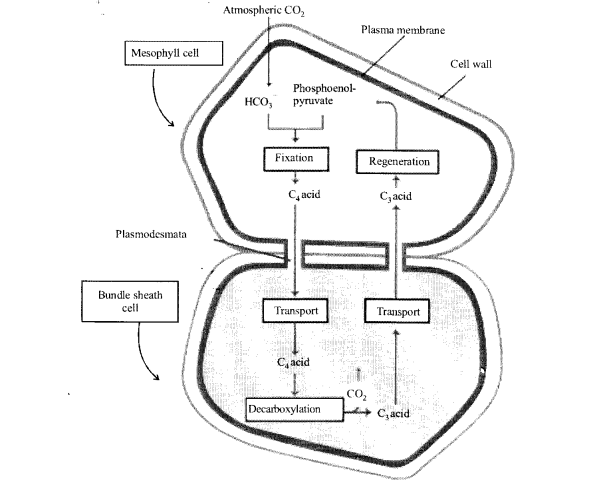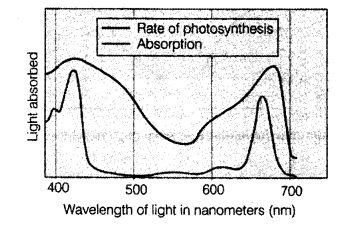NCERT Exemplar Solutions for Class 11 Biology Chapter 13 Photosynthesis
These Solutions are part of NCERT Exemplar Solutions for Class 11 Biology. Here we have given NCERT Exemplar Solutions for Class 11 Biology Chapter 13 Photosynthesis.
VERY SHORT ANSWER QUESTIONS
Question 1.
Examine the figure.

(b) Can these be passed on to the progeny? How?
(c) Name the metabolic process taking place in the places marked (A) and (B).
Solution:
(a) Figure shows the chloroplast, which is green
in colour and performs photosynthesis in plants. The structure is present in plant cell.
(b) Yes, chloroplast has the power of self replication because of presence of extra nuclear DNA. Hence, known as semi- autonomous organelle.
(c) The metabolic processes that occurs in the marked places are as follows.
A-It is the stroma of chloroplast, where dark reaction of photosynthesis takes place.
B-It is the structure of extra nuclear DNA that is responsible for replication of chloroplast, when it is required in the photo synthesising cells.
Question 2.
2H2O—>4H+ + O2 + 4e–
Based on the above equation, answer the following questions
(a) Where does this reaction take place in plants?
(b) What is the significance of this reaction?
Solution:
(a) This reaction takes place in reaction centre
PS II, that is located on the inner surface of thylakoid membrane. It is known as water splitting centre, where electrons are extracted from water and the reaction is catalysed by Mn+ and Cl– ions.
(b) Spliting of water is an important event in photosynthesis are
(i) It liberates molecular oxygen as byproduct of photosynthesis and is the significant source of oxygen in air, or is essential for all living beings on earth.
(ii) Hydrogen ions produced takes part in reducing NADP to NADPH. It is a strong reducing agent.
(iii) The electrons released are transferred from PS II to PS I through a series of electron carriers thus, creating a gradient for the ATP synthesis.
Question 3.
Cyanobacteria and some other photosynthetic bacteria don’t have chloroplasts. How do they conduct photosynthesis?
Solution:
- In Cyanobacteria complex lamellar system (thylakoids) are present instead of chloroplast. These thylakoids are functionally analogous to the plastids of eukaryotic cells.
- Pigment like chlorophyll-a, C-phycocyanin, C-phycoerythrin embedded in these lamellar system and they trap solar energy and perform photosynthesis. They perform oxygenic photosynthesis.
- Photosynthetic bacteria possess related pigments called bacterichlorophyll which are of different types (a,b,c,d,e,f and g). Groups that contain chlorophyll, perform photosynthesis, but do not evolve oxygen.
- Bacteriochlorophyll, perform photosynthesis but do not evolve oxygen.
- Bacteriochlorophylls are photoreceptors similar to chlorophylls except for the reduction of an additional pyrrole ring and other minor differences that shift their absorption maxima to near infrared, to wavelength as long as 1000 nm.
- Thus, they utilize light wavelengths not used by green plants or cyanobacteria.
- Bacteriopheophytin is a variant of bacteriochlorophyll that has two protons are present instead of magnesium ion at its centre.
Question 4.
(a) NADP reductase enzyme is located on ……..
(b) Breakdown of proton gradient leads to release of ……….. .
(b) ATP molecules
Solution:
(a) NADP reductase enzyme is located on the outer side of thylakoid membrane.
(b) ATP molecules
Question 5.
Can girdling experiments be done in monocots? If yes, how? If no, why note?
Solution:
The girdling experiment cannot be done in monocots. The monocots vascular bundles are scattered all over the width of stem, so we cannot get the specific band of the phloem tissue which we get in dicot.
Question 6.
3CO2, + 9ATP + 6NADPH + water –>Glyceraldehyde 3-phosphate + 9ADP + 6NADP+ + 8Pi.
Analyse the above reaction and answer the following questions
(a) How many molecules of ATP and NADPH are required to fix one molecule of CO2?
(b) Where in the chloroplast does this process occur?
Solution:
(a) 2 molecules of ATP for phosphorylation and
two molecules ofNADPH for reduction are required to fix one molecule of CO2 (b) The calvin cycle occurs in the stroma of the chloroplast.
Question 7.
Does moonlight support photosynthesis? Find out.
Solution:
Moonlight does not carry enough energy to excite chlorophyll molecules, i.e; reaction centre PSI and PSII, so light dependent reactions are not initiated. Thus, photosynthesis cannot occur in moonlight.
Question 8.
ATPase enzyme consists of two parts. What are those parts? How are they arranged in the thylakoid membrane? Conformational change occur in which part of the enzyme?
Solution:
ATP synthase enzyme consists of two parts:
(a) F1– head piece is a peripheral membrane protein complex and contain the site for synthesis of ATP from ADP + pi (inorganic phosphate).
(b) F0-integral membrane protein complex that form the channel through which proton cross the inner membrane.
The arrangement of F1 and F0 in thylakoid membrane is as follows.
F0– is a portion present within the thylakoid membrane.
F1 is a portion of ATP synthase enzyme present in the stroma of chloroplast.
The conformational change occurs in F1 portion of ATP synthase thus, it facilitates the ATP synthesis.
SHORT ANSWER QUESTIONS
Question 1.
Succulents are known to keep their stomata closed during the day to check transpiration. How do they meet their photosynthetic C02 requirements?
Solution:
Succulent plants grow in dry and xeric conditions so, to prevent water loss through transpiration the stomata remains closed during day time. So that the gaseous exchange does not take place.
Thus plants have developed the mechanism to fix C02 during night in the form of malic acid, which is a 4 carbon compound and are released during the day, inside the photosynthetic cells.
Question 2.
Chlorophyll-‘a’ is the primary pigment for the light reaction. What are accessory pigments? What is their role in photosynthesis?
Solution:
Accessory pigments are also photosynthetic pigments, like chlorophyll-/), xanthophyll and carotenoids which are not directly involved in emission of excited electron, but they help in harvesting solar radiation and pass it on to chlorophyll-o.
This pigment itself absorbs maximum radiation at blue and red region. So the chief pigment of photosynthesis is chlorophyll and others (i.e, chlorophyll-/; xanthophyll and carotenoid) are accessory pigments.
Question 3.
Do reactions of photosynthesis called, as ‘Dark Reaction’ need light? Explain.
Solution:
Dark reactions is a type of independent reactions. Through various biochemical reactions CO2 is reduced to produce C6H12O6 (glucose) which does not need light. But they depend on the products formed during light reactions, i.e., NADPH2 and ATP.
Question 4.
How are photosynthesis and respiration related to each other?
Solution:
Photosynthesis and respiration are related to each other as in both mechanisms, the plants gain energy.
In photosynthesis, plants gain energy from solar radiations whereas, in respiration, they break down glucose molecule to get energy in the form of ATP molecules.
The product of photosynthesis i.e., glucose (food) is utilised in respiration to yield energy in the form of ATP. While doing so, it release many other simple molecules (CO2 + H2O) that are utilised in photosynthesis to produce more sugar.
Question 5.
If a green plant is kept in dark with proper ventilation, can this plant carry out photosynthesis? Can anything be given as supplement to maintain its growth or survival?
Solution:
The plant in given conditions cannot carry out photosynthesis. Light is necessary for any green plant to make its own food. The plant should be watered properly for its survival.
Question 6.
Photosynthetic organisms occur at different depths in the ocean. Do they receive qualitatively and quantitatively the same light? How do they adapt to carry out photosynthesis under these conditions.
Solution:
Mostly algae are present at various depth in ocean. These show great variations in its photosynthetic pigment. These can absorb different wave lengths of light and could perform photosynthesis.
Green algae-chlorophyll-o, (absorbs red) and b(absorbs blue violet).
Brown algae-chlorophyll-o, c and fucoxanthin (absorbs yellow).
Rhodophyceae-chlorophyll-o, d and phyocoerythrin.
Question 7.
What conditions enable RuBisCO to function as an oxygenase? Explain the ensuing process.
(a) Can we artificially induce the property of nitrogen-fixation in a plant, leguminous or non leguminous?
(b) What kind of relationship is observed between mycorrhiza and pine trees?
(c) Is it necessary for a microbe to be in close association with a plant to provide mineral nutrition? Explain with the help of one example.
Solution:
This is an enzyme that has dual nature. When CO2 concentration is good enough in atmosphere. It acts as carboxylase. But if concentration of O2 increase, its nature changes and it binds with O2 and acts as oxygenase enzyme that forces CO2 to enter in C2 cycle that leads to photorespiration and loss of CO2.
Question 8.
Why does the rate of photosynthesis decrease at higher temperatures?
Solution:
Photosynthesis is an enzyme specific process. All enzymes works at an optimum temperature (/. e., 25-35°C). As temperature increases, enzyme gets denatured thus leading to fall in the rate of photosynthesis.
Question 9.
Explain how during light reaction of photosynthesis, ATP Synthesis is a chemiosmotic phenomenon.
Solution:
- In light reaction plants solar radiation is trapped by photosynthetic pigments, which converts light energy into chemical energy.
- Photophosphorylation is the main event of light reaction i.e., formation of ATP from ADP + Pi by using energy of excited electron movement through electron transport chain, that is present in thylakoid membrane.
- The movement of ions across a selectively permeable membrane, down the electrochemical/ proton gradient is known as chemiosmosis.
- Chemiosmosis hypothesis of ATP formation was first proposed by Mitchell (1961), according to ATP generated by enzyme ATP synthase via a membrane, proton pump and proton gradient.
- ATP synthase allows ions 02 protons to pass through membrane and proton pump.
- Which creates a high concentration of protons (H+) in the lumen and hence diffuses across the membrane to activate ATPase, releasing ATP molecules. One molecule of ATP is released for every two (H+) ions passing through ATPase.

Question 10.
In What kind of plants do you come across ‘Kranz anatomy’? To which conditions are those plants better adapted? How are these plants better adapted than the plants, which lack this anatomy?
Solution:
-
- Kranz anatomy how dimorphism in the chloroplast structure. It is found in C4 plants. The cells of leaves consists two types of chloroplast in them.
- Granal Chloroplast is found in the mesophyll cells of leaves.
- Chloroplast have well developed grana in them. These chloroplast fixes C02 effectively even if it is present in lower concentrations.
- PEP carboxylase fixes CO2 to form oxaloacetic acid (4 carbon compound).
- Agranal Chloroplast is found in bundle sheath cells of the leaves. C3 cycle occurs in these cells in the presence of RuBisCo enzyme.
- The C4 plants are well adapted to high O2 concentrations and high temperature.
C4 plants can absorb CO2 even when CO2 concentration in much low thus C4 plants can perform high rate of photosynthesis even the stomata are closed or there is the shortage of water thus, they can conserve water. - Since, PEP-carboxylase is insensitive to O2 thus excess O2 has inhibitory effect in C4 pathway and no photosynthesis occurs in C4 plant.
- Thus, C4 plants are better adapted to tropical and desert (hot acid habitats) areas than the plants, that lack kranz anatomy.
Question 11.
Tomatoes, carrots and chilies are red in colour due to the presence of one pigment. Name the pigment. Is it a photosynthetic pigment?
Solution:
The pigments are chromoplasts, these are fat soluble carotinoid pigments like carotenes and xanthophylls. These are called accessory pigments, they absorb light and transfer energy to Chlorophyll a.
Question 12.
Observe the diagram and answer the following.

(a) Which group of plants exhibit these two types of cells?
(b) What is the first product of C4 cycle?
(c) Which enzyme is there in bundle sheath cells and mesophyll cells?
Solution:
(a) Monocot plants that belongs to Graminae/
Poaceae family, e.g., sugarcane, maize etc., possess these two types of cells, i.e., bundle sheath and mesophyll cell (in kranz anatomy).
(b) First product of C4 cycle is 4-carbon compound oxaloacetic acid.
(c) Mesophyll cells consists PEP carboxylase enzyme to fix atmospheric C02 to form 4-carbon compound oxalo acetic acid, whereas bundle sheath cells consists RuBP carboxylase that fixes C02 to form 3-carbon compound 3 PGA (3 phosphoglyceric acid).
LONG ANSWER QUESTIONS
Question 1.
In the figure given below, the back line (upper) indicates action spectrum for photosynthesis and the lighter line (lower) indicates the absorption spectrum of chlorophyll-a, answer the following

(a) What does the action spectrum indicate? How can we plot an action spectrum? Explain with an example.
(b) How can we derive an absorption spectrum for any substances?
(c) If chlorophyll-a is responsible for light reaction of photosynthesis, why do the action spectrum and absorption spectrum not overlap?
Solution:
(a) Action spectrum depicts the relative rates of
photosynthesis at different wavelenghths of light. Action spectrum of photosynthesis can be plotted by measurement of oxygen evolution at different wavelength. Englemann (1882) by using a green algae plotted action spectrum.
(b) Absorption spectrum of a substance can be derived by calculating amount of energy of different wavelength of light absorbed.
(c) Chlorophyll a is responsible for light reaction of photosynthesis, but the action spectrum and absorption spectrum do not overlap because, though chlorophyll a is the main pigment responsible for the absorption of light, other thylakoids pigment like chlorophyll b, xanthophylls, carotenoids,
which are accessory pigments also absorb and transfer the energy to chlorophyll a. Indeed they not only enable a wider range of wavelength of incoming light to be utilized for photosynthesis but also protect chlorophyll from photo-oxidation.
Question 2.
What are the important events and end products of the light reaction?
Solution:
Following are important events of light reaction:
(i) Excitation of chlorophyll molecule to release a pair of electrons and use their energy in the formation of ATP from ADP + Pi. This process is known as photophosphorylation.
(ii) Splitting of water molecule
(a) 2H2O —» 4H+ + 4e– + 0+↑
(b) NADP + 2H+ ->NADPH2
End products of light reaction are NADPH and ATP. Reducing power is produced in the light reaction i.e., ATP and NADPH2 molecules that are used up in dark reaction and O2 is evolved as a by product by the splitting of water.
Question 3.
Why does not photorespiration take place in C4 plants?
Solution:
- Photorespiration is associated with C3 cycle, where plant lose CO2 fixation due to the increase in concentrate ion of O2 change in the nature of activity of RuBP carboxylase-oxygenase.
- While C4 plants have evolved a mechanism to avoid loss of CO2.
- There is not a direct involvement of RuBP carboxylase-oxygenase as C3 cycle operates in bundle sheath cells, where both temperature and oxygen level low.
- CO2 fixation occurs by another enzyme PEP carboxylase in mesophyll cells andoxaloacetate is formed, that is later converted into malic acid and transported to bundle sheath cells.
- There, it liberates CO2, which is used in Calvin cycle, operating in bundle sheath cells of C4 plants.
- We hope the NCERT Exemplar Solutions for Class 11 Biology at Work Chapter 13 Photosynthesis, help you.
- If you have any query regarding NCERT Exemplar Solutions for Class 11 Biology at Work Chapter 13 Photosynthesis, drop a comment below and we will get back to you at the earliest.
We hope the NCERT Exemplar Solutions for Class 11 Biology at Work Chapter 13 Photosynthesis, help you. If you have any query regarding NCERT Exemplar Solutions for Class 11 Biology at Work Chapter 13 Photosynthesis, drop a comment below and we will get back to you at the earliest.